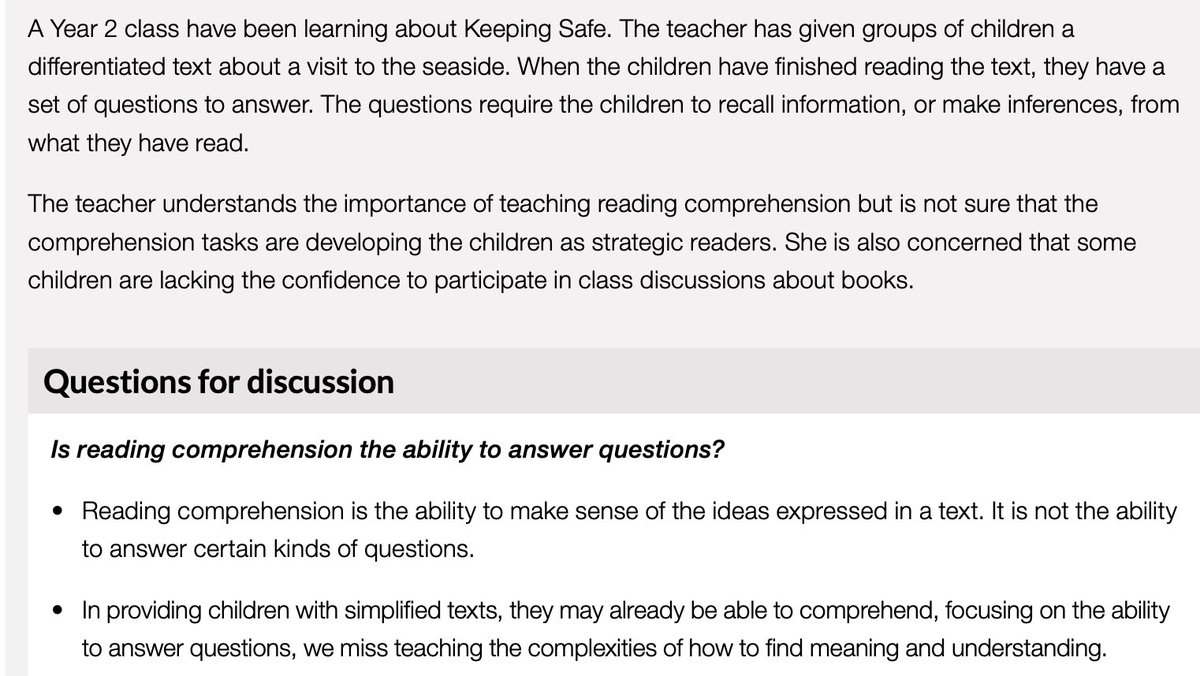A few thoughts on the EEF’s updated guidance report for KS1 (Y1/2 ) literacy regarding recommendation 4.
I am happy with what is said in the second picture. I hope many teachers have also experienced this - that answering comprehension questions does not make a better reader 1/
I am happy with what is said in the second picture. I hope many teachers have also experienced this - that answering comprehension questions does not make a better reader 1/
The big daddy of analysis into Reading Instruction is the National Reading Panel of 2000. They looked at 203 papers on comprehension and found that ‘instruction of comprehension has been successful over the 3rd to 6th grade range.’
That is Y4 to Y7 in the UK…u2028
/2
That is Y4 to Y7 in the UK…u2028
/2
Here the EFF claim comprehension can improved through explicit teaching.
It can.
But it is not clear if this is the case in KS1 as per what the NRP say.
From NRP:u2028
‘A next step will be to determine… which strategies, in combination, are best for younger readers.’
/3
It can.
But it is not clear if this is the case in KS1 as per what the NRP say.
From NRP:u2028
‘A next step will be to determine… which strategies, in combination, are best for younger readers.’
/3
Remember the NRP that analysed 203 papers into comprehension? Prediction was not one of them…
@TheReadingApe has a good blog on this here - https://www.thereadingape.com/single-post/2020/05/02/I-predicta-riot
/5">https://www.thereadingape.com/single-po...
@TheReadingApe has a good blog on this here - https://www.thereadingape.com/single-post/2020/05/02/I-predicta-riot
/5">https://www.thereadingape.com/single-po...
The earliest account I can find on the use of & #39;Prediction’ comes from reciprocal teaching (RT) (Palincsar & Brown (1984) where pupils ‘generate questions, summarizing, attempting to clarify word meanings… and predicting what might appear in the next paragraph.’
/6
/6
It is worth noting that the only predicting that should take place was only that of the next paragraph. Rosenshine (yes, the 10 principles) and Meister conducted a meta analysis on RT. Some studies did not stick the 4 strategies above, some used 2,3 or 10. The findings…
/7
/7
No way in knowing if teaching the prediction skill was the reason for the gains seen.
The next issue comes with the reference that the EFF give for the use of strategies, which is Oakhill et al’s excellent book (my take is here - https://nutsaboutteaching.wordpress.com/2020/07/30/ramble-13-reading-comprehension-more-than-just-background-knowledge/)
/8">https://nutsaboutteaching.wordpress.com/2020/07/3...
The next issue comes with the reference that the EFF give for the use of strategies, which is Oakhill et al’s excellent book (my take is here - https://nutsaboutteaching.wordpress.com/2020/07/30/ramble-13-reading-comprehension-more-than-just-background-knowledge/)
/8">https://nutsaboutteaching.wordpress.com/2020/07/3...
A search for prediction in the book only brings up 5 results. 2 of which are references used within the book. The other three do not mention it explicitly as a strategy.
There is however a strong evidence base for the other strategies mentioned (though they miss some off)
/9
There is however a strong evidence base for the other strategies mentioned (though they miss some off)
/9
But as stated, little to no evidence of their use in KS1. Indeed while you can practice these skills, Oakhill writes that this will be done when books have been read to the students. While listening and reading comprehension are highly correlated they are not the same.
/10
/10
Where I feel the EEF does not go far enough is in the following:
I would hope that they know what comprehension lessons generally look like in most primary schools where a strategy/skill (not the same thing) is taught a day a week… and repeated and recycled.
/11
I would hope that they know what comprehension lessons generally look like in most primary schools where a strategy/skill (not the same thing) is taught a day a week… and repeated and recycled.
/11
There is debate as to how much instruction is needed for each strategy until the gains run out…
Another good paper on reading ‘ending the reading wars’ says…
/12
Another good paper on reading ‘ending the reading wars’ says…
/12
Evidence from Rosenshine and Meister Meta-Analysis earlier shows how many sessions each study they looked at had. Notice the difference in effect size compared to Length in
Williamson, 1989, Jones, 1987 - APP A
Fischer Galbert, 1989 and Labercane & Battle, 1987 - APP B
/13
Williamson, 1989, Jones, 1987 - APP A
Fischer Galbert, 1989 and Labercane & Battle, 1987 - APP B
/13
While Shanahan -
#sthash.9uzkXsdA.WmZSd6UF.dpbs">https://www.shanahanonliteracy.com/blog/the-spirit-is-willingham-but-the-flesch-is-weak-1 #sthash.9uzkXsdA.WmZSd6UF.dpbs">https://www.shanahanonliteracy.com/blog/the-... - doubts Willingham’s initial 2 week is all you need, he does concede that ‘there is certainly no evidence that there are benefits to be derived from 8 to 10 years of 30-35 weeks of strategy teaching.’
/14
#sthash.9uzkXsdA.WmZSd6UF.dpbs">https://www.shanahanonliteracy.com/blog/the-spirit-is-willingham-but-the-flesch-is-weak-1 #sthash.9uzkXsdA.WmZSd6UF.dpbs">https://www.shanahanonliteracy.com/blog/the-... - doubts Willingham’s initial 2 week is all you need, he does concede that ‘there is certainly no evidence that there are benefits to be derived from 8 to 10 years of 30-35 weeks of strategy teaching.’
/14
https://educationendowmentfoundation.org.uk/news/eef-blog-improving-reading-comprehension-through-strategy-instruction/
Seeing">https://educationendowmentfoundation.org.uk/news/eef-... as the EEF are happy to quote Rosenshine and Meister’s finding of a .32 effect size on RT in this blog, I do find it a strange omission that they do not discuss the disparity of length of the studies used giving the topic of the blog.
/15
Seeing">https://educationendowmentfoundation.org.uk/news/eef-... as the EEF are happy to quote Rosenshine and Meister’s finding of a .32 effect size on RT in this blog, I do find it a strange omission that they do not discuss the disparity of length of the studies used giving the topic of the blog.
/15
To be clear, where I think the EFF need to be more explicit in this recommendation is that you do not need to be spending whole lessons all year on these strategies. I do want them to also address the lack of evidence for their use at KS1.
/16
/16

 Read on Twitter
Read on Twitter
















